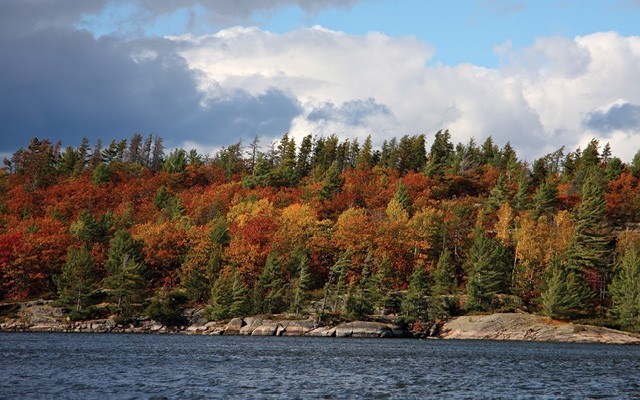On the second crossing of a portage this September, deep within the wild woods of Central Ontario, I drank in the last remnants of summer. Having carried the canoe on my first pass, I took my time on the second. In glorious sun with everything electric, new smells wafted past with regularity. From the forest's white noise my ears untangled both a woodpecker's distant drilling for insect gold, and the soft, pattering rain of tent-caterpillar poo (I'll admit that one's an acquired sound).
My eyes hopscotched through the chiaroscuro of light and shadow in the understory, catching the vermillion flash of newly fallen leaves dotting the brown litter like small explosions. Ah... fallen leaves. The equinox was coming. The last, lazy exhalations of summer that swayed the canopy above were heralding the sharper inhalations of autumn, prelude to the icy, breath-holding quiet of winter.
Whenever I find myself on the cusp of seasonal change, I'm wont to recall the entirety of this dramatic annual arc. So that day, there wasn't just the theatre of summer to dwell on, but what led into it. Having daily viewed from my canoe evidence of this bailiwick — Ice marks on shoreline rocks, lakeside browse lines, sap streaks on trees, low water levels, squadrons of geese winging south — it wasn't hard to imagine the lock-down of black-and-white winter, where snow-covered beaver lodges offered a reminder of life breathing quietly beneath it all, patiently awaiting the vernal maiden.
It was equally easy to imagine her arriving, the spring wood after the thaw, before the insects were out or the birds had returned, when regiments of green-and-white Trilliums sprouted from tan mats, hinting at life-blood syrups boiling up through the trees. And now, though the forest seemed locked still in industry, the evidence said otherwise. It was powering-down, the longer, colder nights drawing the leaves into biochemical ballet, a fungible shift from summer's vibrant green to the red, orange, and yellow palette of fall.
Once upon a time I learned how all this worked in a plant physiology course, dooming me to remember it each fall as I watch the chromatic shuffle. I'll share it, but before considering how the different chemical compounds involved contribute to what we see, I should explain how the pigments originate. The first place to look is at the chemical bonds they contain. These can be either single (one shared pair of electrons between neighbouring atoms), or double (two shared pairs of electrons), but the molecules responsible for colour contain alternating single and double bonds — a system referred to as conjugation. Lots of conjugation going on means a molecule can absorb different wavelengths of light in the visible spectrum, which leads to the refraction of those colours.
Most people can tell you that chlorophyll — the molecule within the organelles known as chloroplasts that run a leaf's metabolic machinery — is responsible for the green colour of most plants. An essential component of photosynthesis, in which plants convert carbon dioxide and water into sugars using only the energy of the sun, the production of chlorophyll itself requires warmth and sunlight. As these factors wane with the passing of summer, days shorten quickly after the September equinox (you may have noticed sunset is two minutes earlier every night), production of new chlorophyll slows while decomposition of pre-existing molecules accelerates. Once chlorophyll is out of the picture, other compounds present in the leaves step up to affect the next phase of colouration.
As chemical families go, both carotenoids and flavonoids are large ones. Lurking right alongside chlorophyll, higher levels of the green stuff during summer mask these pigments. But as chlorophyll begins to degrade, they immediately make themselves visible; both groups of compounds contribute yellows to the game, but it's carotenoids that are responsible for the vibrant oranges and reds that light up Eastern Canada's deciduous forests (or Creekside's transplanted one). These molecules also degrade as autumn progresses, but much slower than the more-fragile chlorophyll. Notable carotenoids include the familiar orange beta-carotene of carrots, the lycopene responsible for tomato red, and lutein, which lends egg yolks their bright yellow.
And then there's anthocyanins. Unlike carotenoids and fellow flavonoids, you won't find anthocyanins in leaves year-round. Instead, their synthesis is initiated by an increase in sugars in fall leaves reacting with sunlight. Anthocyanins bring magenta, purple and red hues to leaves, their vividness often tied to the acidity of a tree's sap (meaning a big environmental component from both soil and weather). Though plant biologists remain uncertain of their role, anthocyanins may help protect leaves from light damage, extending their time on the branch.
Eventually, of course, all leaves are shed, clamouring to the ground in a rain of colour, borne on the cold winds of autumn. Mostly they are bound for decay, a restarting of the forest's nutrient cycle. Some will suffer the ignominy of the Muni's ridiculous leaf-blowers, but others will find their way into the forest, where you, like I, can contemplate the heroic cycle of creation, transformation, and termination they represent.
Leslie Anthony is a Whistler-based author, editor, biologist and bon vivant who has never met a mountain he didn't like.




